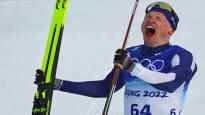Jan Vapaavuori, Chairman of the Olympic Committee, said: Finland’s top sport is narrow. So narrow that the view for four years is not rosy, writes Atte Husu.
The two gold candidates were above the others when the Beijing Olympics medal cuts were drawn up before the Games.
Iivo Niskanen had won both traditional start races in the World Cup, and second, both domestic and foreign puck experts estimate that the absence of NHL players from the Olympic Trail would play into the Lions ’bag.
Both gold seams were realized. The Finnish Olympic team won more than one gold medal for the first time since the 2002 Salt Lake City Winter Games.
With a total of eight medals, the precious metal came in second most in terms of this millennium and third most in the professional era that began in the late 1980s.
The first medals were awarded in Beijing on 5 February. Iivo Niskasen the bronze of the combination competition raised the domestic colors to the medal table the very next day. When the Lions crowned the Games with their historic Olympic gold on February 20, Finland was involved in the success caravan from the start of the Games to the finish.
At the beginning of February, the twists and turns related to the corona testing of the Olympics were circulated in the media with such a volume that there is no more line in the text on the topic of k. The competition was held, the athletes played sports. Everyone knew the spirit of the game.
The familiar dominance continued
The great days of Finnish winter sports were celebrated in Sarajevo in 1984, when the team returned home with a record catch: 4 gold, 3 silver and 6 bronze. Notable for the 13 medals, however, were that they came from three sports, namely cross-country skiing, hill jumping and combined.
Since then, success at the Winter Olympics has been quite second-class in its number of medal sports: in Turin in 2006, Finnish athletes lost five-ring medals from as many as eight sports.
However, in the winter competitions of 2010, 2014 and 2018, medals came no longer from cross-country skiing, hockey and snowboarding. Of these three, snowboarding fell in Beijing, where the Finnish team had the weakest result in the sport’s 24-year Olympic history. Before Rukajärvi seventh place was still the second best result of a Finnish individual athlete if cross-country skiers are excluded from the calculations.
In Beijing, the bottom contact was also seen in the hill landing and in the exclusive figure skating that has been involved since 1924 – that is, when Finland has had a representative. Tero Seppälä ninth place in the final trip saved the biathlon out of this club.
In alpine skiing, six of the four performances of four Finns ended in an interruption with the best place being 37. When a Finnish skier has been involved, only Calgary has gone worse in 1988, when Nina Ehnrooth interrupted the competition as the only Finnish skier in both sports.
Unlike the previous winter competitions in Pyeongchang, Finland had no representation in curling and speed skating in Beijing.
Level result
Reading the above-mentioned litany, one could imagine that the Finnish team underperformed hard in Beijing. That is not the case.
When Sports went through the previous comparable World Championship results in each sport – the same program was last in cross-country skiing in 2019 – and compared them to the Beijing standings, the games now seen were a step forward in terms of numbers.
In Beijing, 26 out of 45 competitions performed better than in previous World Cups.
In Beijing, the majority of Finnish athletes saw a result that was fully in line with this season’s level. For many, it meant international screen time at the departure gate or at the finish line.
Iivo and Kerttu Niskanen mixed Krista Pärmäkoski arrived in Beijing as athletes, forming the top three in terms of the average results seen in the World Cup. They were also responsible for all personal medals of the Finnish Olympic team.
Who are you looking at 2026?
The most worrying thing about the results of the Finnish team is that all personal medalists are over 30 years old. Pärmäkoski, 31, said he skied his last Olympic start on Sunday with a high probability, and of Niskanen’s siblings, Iivo will be 34 years old and his big sister Kerttu 37 at the next Winter Olympics.
In Sweden, the situation is quite different. The Blue Yellow set their Winter Olympics record in Beijing by winning 8 gold, 5 silver and 5 bronze. The personal medal was won by ten athletes, only one of whom is 30 years old. The average age of these Swedish medalists is 25.9 years.
As Kerttu Niskanen showed, winning the first personal value medals is possible at the end of his career. Becoming a long-term success on personal trips is still a separate issue, as Iivo Niskanen and Pärmäkoski, who passed through under the age of 23, have proved.
Finnish top sports need role models. The Beijing Games were the best medicine for it. There is cause for satisfaction, from home-based bench athletes to the leadership of the Olympic Committee. At the same time, however, there is reason to ask whether the Finnish sports community dares to face the realities behind the medals.
With a view to the 2026 Cortina d’Ampezzo and Milan Winter Games, it is only certain that Finland will be a medal favorite in men’s and women’s hockey.
